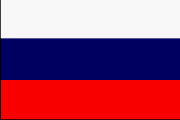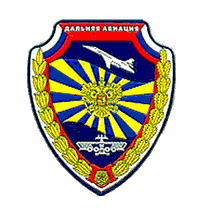



37th Supreme Command (Strategic) Air Army
[ex-Long Range Aviation (DA, Dal'nyaya Aviatsiya)
 Strategic aviation is an intercontinental nuclear strike force that in the mid-1990s included about 15,000 personnel. In concert with the strategic rocket forces, it provides the Russian Federation's strategic nuclear threat. Organizationally, strategic aviation fell under the Long-Range Aviation Command of the air forces, but it was under the operational control of the Ministry of Defense. Bases are located in the Far Eastern, Moscow, and Northern military districts. According to the reckoning of START I, strategic aviation aircraft could deliver a total of 1,506 nuclear warheads, including bombs, cruise missiles, and air-to-surface missiles.
Strategic aviation is an intercontinental nuclear strike force that in the mid-1990s included about 15,000 personnel. In concert with the strategic rocket forces, it provides the Russian Federation's strategic nuclear threat. Organizationally, strategic aviation fell under the Long-Range Aviation Command of the air forces, but it was under the operational control of the Ministry of Defense. Bases are located in the Far Eastern, Moscow, and Northern military districts. According to the reckoning of START I, strategic aviation aircraft could deliver a total of 1,506 nuclear warheads, including bombs, cruise missiles, and air-to-surface missiles.
Following the breakup of the Soviet Union, a significant portion of modern heavy bombers turned out to be in Ukraine and Kazakhstan. This resulted in Russia having only 25 heavy bombers of a total number of 99 that belonged to the USSR that were capable of carrying cruise missiles, along with 61 bombers with nuclear weapons that did not carry cruise missiles. The Russian Air Force decided in November 1995 to buy all 19 Tu-160 "Blackjack" and 25 Tu-95 "Bear" bombers and more than 300 strategic cruise missiles from Ukraine.
Organization
Russia's armed forces underwent major organizational changes from July 1997. Long-range aviation and military transport aviation commands were reorganized as air armies of the Supreme High Command. As part of this reform, the Long-Range Air Force was eliminated, with its units becoming the 37th Air Army (Strategic) of the Supreme High Command (SHC).
The Far Eastern force deploys 107 Tu-95 Bear bombers of the G and H models and twenty Tu-160 Blackjack bombers. The Northern and Moscow military districts each house a heavy bomber regiment of twenty modern Tu-22M high-performance jet bombers. The Tu-22M has less range than the older Tu-95 models, but it is better suited to modern air warfare. According to experts, the Bears are located in Asia because they match China's obsolete air defenses, and the more modern aircraft are in Europe to be matched against the more formidable West European defenses.
37th Supreme Command (Strategic) Air Army
22nd Heavy Bomber Division (22 tbad), Engel's
73rd Heavy Bomber Division (73 tbad), Ukrainka - Tu-95
106th Uzinskaya Heavy Bomber Division (106 tbad), Uzin, Ukraine
409th Heavy Bomber Rgmt (409 tbad), Uzin, Ukraine - Tu-95M
1006th Heavy Bomber Rgmt (1006 tbad), Uzin, Ukraine - Tu-95M
182nd Heavy Bomber Rgmt (182 tbap), Mozdok, North Ossetia - Tu-95MS
Heavy Bomber Division (??? tbad), Dlora - M-4
Arctic Control Group Base, Anadyr AB
Arctic Control Group Base, Mys Shmidia AB
Arctic Control Group Base, Olen'ya AB
Arctic Control Group Base, Tiksi AB
Arctic Control Group Base, Vorkuta AB
A command and staff exercise of the 37th Supreme Command (Strategic) Air Army was held on 6-8 October 1998 involved all strategic aviation divisions and regiments. The exercise involved a scenario in which the politico-military situation in Europe had abruptly aggravated when NATO stepped up the realization of the program of enlargement eastwards by admitting new states of the former Soviet bloc. A number of East European countries e laid territorial claims on their neighbour states, including the Russian Federation. The claims laid on Russia deal with the allegedly decreasing safety of the nuclear installations and facilities. Russia was threatened with the use of force, unless it complied with a number of NATO ultimatums. In the exercise scenario the Russian Air Force responded with limited demonstration nuclear strikes. The Tu-95MS Bear-H and Tu-160 Blackjack bombers will deliver Kh-55SM cruise missile attacks on uninhabited polar areas. Although such operations will not inflict losses on the enemy, it will be forced to halt operations and proceed to talks.
A total of 78 sorties were flown including 56 sorties of the 37th Air Army aircraft and 13 sorties of fighters. It was the first time when the exercise of such a scale was held in Russia. In the course of the maneuvers the aircraft made 15 ground bombings and two combat training missile launches, i.e. the Kh-55SM strategic missile launch from the Tu-95MS Bear-H and the Kh-22 theater missile launch from the Tu-22M3 Backfire. The launches were made at the proving ground near the Caspian Sea, with the bombers flying to the launching areas using the so-called mirror routes. It means that upon covering the half of the route to the target, the aircraft turned back and flew to the proving ground where they performed their combat training mission. Tu-22MR aircraft made two electronic reconnaissance sorties to the Japan Sea without entering the aerospace of the neighbouring states.
Soviet-era Organization
The Strategic Air Armies were organized in the late 1970s from elements of Long-Range Aviation. Their mission was to attack the enemy's strategic delivery systems and infrastructure, including missile and bomber bases. The Strategic Air Armies were organized into air armies of bomber aircraft of several types. In 1989 these included Tu-95 long-range strategic bombers, a type first deployed in the late 1950s and continuously upgraded since then. Since the early 1980s, more than seventy of these bombers have been modified to carry air-launched cruise missiles (ALCMs). A new intercontinental-range bomber, the Tu-160, which also bears the North Atlantic Treaty Organization (NATO) designation Blackjack, became operational in 1989. In the late 1980s, long-range bombers carried a small, but increasing, percentage of all Soviet strategic nuclear weapons.
Although its name implies an intercontinental mission, most Strategic Air Armies aircraft were medium- and short-range bombers. In 1989 the Soviet Union had Tu-16, Tu-22 and Tu-26 medium-range bombers. The Tu-16 and Tu-22 aircraft entered service in large numbers in the early 1960s. The Tu-26, sometimes called the Tu-22M and designated the Backfire bomber, was first fielded in 1974. In 1989 the Strategic Air Armies also included Su-24 fighter-bombers, which had a combat radius of over 1,000 kilometers. Medium-range bombers and fighter-bombers would support military operations by striking the enemy's nuclear delivery systems, airfields, air defense systems, and command, control, and communications facilities in a theater of war.
In the early 1980s Soviet strategic bombers and strike aircraft were restructured to form five air armies subordinate to the Supreme High Command(VGK):
- Smolensk Air Army
- Legnica Air Army
- Venitza Air Army
- Irkutsk Air Army
- Moscow Air Army
These armies were established to place Soviet strategic aircraft on a footing in peace time that would facilitate the transition to wartime. The armies are focused on potential conflicts in Europe, Asia, and the United States.
The detailed organization of Long Range Aviation remains obscure, as does the operational status of many units. This list is an inventory of all identifiable units and their subordinations. In some cases Regiments and Divisions have been subordinated to more than one Air Army during their history.
?? Air Army
43d Pilot Combat Training and Conversion Center (43 TsBP i PeLS), Ryazan - Tu-22M
Heavy Bomber Training Rgmt (??? utbap), Ryazan - Tu-95U
4th Air Army (4 VA, 4 Vozdushnaya Armiya), [ in Poland until 1992]
149 Bomber Aviation Division
- Szprotawa
3 Bomber Aviation Regiment - Krzywa (30 Su-24)
42 Tannenberski Bomber Aviation Guards Regiment - �aga� (25 Su-24M)
89 Bomber Aviation Regiment - Szprotawa (24 Su-24M)
164 Kercze�ski Bomber Aviation Guards Regiment - Krzywa (12 Su-24R + MiG-25R)
30th Air Army (30 VA, 30 Vozdushnaya Armiya), Irkutsk
Heavy Bomber Division (??? tbad), Bureya - Tu-22M
Heavy Bomber Rgmt (??? tbap), Irkutsk - Tu-22M
Heavy Bomber Division (??? tbad), Zavitinsk - Tu-22
Heavy Bomber Division (??? tbad), Spassk-Dal'nii - Tu-16
Heavy Bomber Division (??? tbad), Ussuriysk - Tu-16
37th Supreme Command (Strategic) Air Army
[ex 36th Air Army (36VA, 36 Vozdushnaya Armiya), Moscow]
22nd Heavy Bomber Division (22 tbad), Engel's
73rd Heavy Bomber Division (73 tbad), Ukrainka - Tu-95
106th Uzinskaya Heavy Bomber Division (106 tbad), Uzin, Ukraine
409th Heavy Bomber Rgmt (409 tbad), Uzin, Ukraine - Tu-95M
1006th Heavy Bomber Rgmt (1006 tbad), Uzin, Ukraine - Tu-95M
182nd Heavy Bomber Rgmt (182 tbap), Mozdok, Ukraine - Tu-95MS
Heavy Bomber Division (??? tbad), Dlora - M-4
Arctic Control Group Base, Anadyr AB
Arctic Control Group Base, Mys Shmidia AB
Arctic Control Group Base, Olen'ya AB
Arctic Control Group Base, Tiksi AB
Arctic Control Group Base, Vorkuta AB
46th Air Army (46 VA, 46 Vozdushnaya Armiya), Smolensk
290th Separate Long range Air Recon Rgmt (290 odrap), Zyabrovka, Belarus - Tu-22
1st Bomber Division (1 bad), Lida, Belarus
305th Bomber Rgmt (305 bap), Postavy, Belarus - Su-24
497th Bomber Rgmt (497 bap), Lida, Belarus - Su-24
953rd Bomber Rgmt (953 bap), Bobrovichi, Belarus - Su-24
22d Heavy Bomber Division (22 tbad), Bobruysk, Belarus
121st Heavy Bomber Rgmt (121 tbap), Machulishchi, Belarus - Tu-22
200th Heavy Bomber Rgmt (200 tbap), Bobruysk, Belarus - Tu-16, Tu-22M
203rd Heavy Bomber Rgmt (203tbap), Baranovichi, Belarus - Tu-22
326th Heavy Bomber Division (326 tbad), Sol'tsy
402d Heavy Bomber Rgmt (402 tbap), Balbasovo, Belarus - Tu-22M
840th Heavy Bomber Rgmt (840 tbap), Sol'sty - Tu-22M
76th Air Army (76 VA, 76 Vozdushnaya Armiya)
79th Heavy Bomber Division (79 tbad), Dolon AB, Semipalatinsk, Kazakhstan
1223d Heavy Bomber Rgmt (1223 tbap), Dolon AB, Semipalatinsk, Kazakhstan - Tu-95MS
1226th Heavy Bomber Rgmt (1226 tbap), Dolon AB, Semipalatinsk, Kazakhstan - Tu-95MS
Unknown Air Army and Bomber Division Subordination
Heavy Bomber Rgmt (??? tbap), Shaykovka - Tu-22M
Heavy Bomber Rgmt (??? tbap), Striy, Ukraine - Tu-22M
Heavy Bomber Rgmt (??? tbap), Tartu, Estonia - Tu-22M
Heavy Bomber Rgmt (??? tbap), Tver' - ???
Heavy Bomber Rgmt (??? tbap), Minerallye Vod - ???
Poltavskaya Heavy Bomber Division (??? tbad), Poltava, Ukraine
Heavy Bomber Rgmt (??? tbap), Poltava, Ukraine - Tu-22M
Heavy Bomber Rgmt (??? tbap), Priluki, Ukraine - 19 Tu-160
Sources and Resources
http://www.fas.org/nuke/guide/russia/agency/vvs_da.htm
Maintained by Webmaster
Updated Thursday, September 07, 2000 7:00:00 AM






 Strategic aviation is an intercontinental nuclear strike force that in the mid-1990s included about 15,000 personnel. In concert with the strategic rocket forces, it provides the Russian Federation's strategic nuclear threat. Organizationally, strategic aviation fell under the Long-Range Aviation Command of the air forces, but it was under the operational control of the Ministry of Defense. Bases are located in the Far Eastern, Moscow, and Northern military districts. According to the reckoning of START I, strategic aviation aircraft could deliver a total of 1,506 nuclear warheads, including bombs, cruise missiles, and air-to-surface missiles.
Strategic aviation is an intercontinental nuclear strike force that in the mid-1990s included about 15,000 personnel. In concert with the strategic rocket forces, it provides the Russian Federation's strategic nuclear threat. Organizationally, strategic aviation fell under the Long-Range Aviation Command of the air forces, but it was under the operational control of the Ministry of Defense. Bases are located in the Far Eastern, Moscow, and Northern military districts. According to the reckoning of START I, strategic aviation aircraft could deliver a total of 1,506 nuclear warheads, including bombs, cruise missiles, and air-to-surface missiles.
